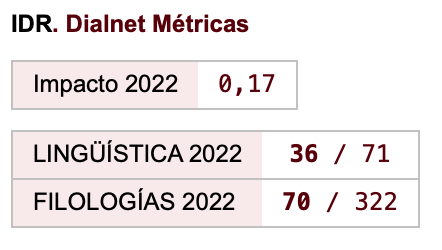An Account of English YES/NO Interrogative Sentences within ARTEMIS
Palabras clave:
Yes/No Interrogatives, Role and Reference Grammar, ARTEMISResumen
As stated in Periñán-Pascual and Arcas Túnez (2010, p. 2671) FunGramKB´s lexical and grammatical levels are grounded in sound linguistic theories, allowing the system to capture syntactic-semantic generalizations which are able to provide both explanations and predictions of language phenomena. The linguistic foundation of FunGramKB is inspired on Role and Reference Grammar (RRG, Van Valin, 2005) and the Lexical Constructional Model (LCM, Ruíz de Mendoza & Mairal Usón, 2008; Mairal Usón & Ruíz de Mendoza, 2008). The close interrelation between these grammatical theories and FungramKB is patent in the design of ARTEMIS (Automatically Representing Text Meaning via an Interlingua-Based System”), an NLP system whose objective is the simulation of natural language understanding. In doing so, ARTEMIS becomes a development of the syntax-to-semantics linking algorithm proposed in RRG which involves a parsing process that starts with a natural language sentence, extracts its morphosyntactic features and provides a representation of these in terms of the so-called layered structure of the clause (LSC) in RRG. Because of its centrality, there is a vital need for a full development of ARTEMIS. This paper aims at contributing to this elaboration by proposing the set of rules and operations necessary for the treatment of Yes/No interrogative sentences within such an NLP system.Descargas
Citas
Cortés-Rodríguez, F. (2016a). Parsing simple clauses within ARTEMIS: The computational treatment of the layered structure of the clause in Role and Reference Grammar. 34th International Conference of AESLA. Alicante, 14-16, April 2016.
Cortés-Rodríguez, F. (2016b). Towards the computational implementation of Role and Reference Grammar: Rules for the syntactic parsing of RRG phrasal constituents. Círculo de Lingüística Aplicada a la Comunicación, 65, 75-108.
Cortés-Rodríguez, F. & Mairal-Usón, R. (2016). Building an RRG computational grammar. Onomázein 34, 86-117.
Díaz-Galán, A. & Fumero-Pérez, M.C. (2016). Developing parsing rules within ARTEMIS: the case of DO auxiliary insertion”. In C. Periñán-Pascual & E. Mestre i Mestre (Eds.), Understanding meaning and knowledge representation: From theoretical and cognitive linguistics to natural language processing (pp.283-302). Cambridge: Cambridge Scholars Press.
Mairal-Usón, R. & Ruiz de Mendoza Ibáñez, F. (2008). Levels of description and explanation in meaning construction. In Ch. Butler & J. Martín Arista (Eds.), Deconstructing Constructions (pp. 153–198). Amsterdam/Philadelphia: John Benjamins.
Periñán-Pascual, C. (2013). Towards a model of constructional meaning for natural language understanding. In B. Nolan & E. Diedrichsen (Eds.), Linking Constructions into Functional Linguistics: The role of constructions in grammar [Studies in Language Companion Series 145] (pp. 205–230). Amsterdam: John Benjamins
Periñán-Pascual, C. & Arcas-Túnez, F. (2010). The architecture of FungramKB. In Proceedings of the 7th International Conference on Language Resources and Evaluation, (pp. 2667-2674). Malta: European Language Resources Association (ELRA).
Periñan-Pascual, C. & Arcas-Túnez, F. (2014). The implementation of the FunGramKB CLS constructor, In B. Nolan & C. Periñán-Pascual (Eds.), Language Processing and Grammars (pp. 165-196). Amsterdam: John Benjamins.
Periñán-Pascual, C. & Mairal Usón, R. (2011). The COHERENT methodology in FunGramKB. Onomázein 24, 13-33.
Quirk, R., Greenbaum S., Leech, G. & Svartvik, J. (1985). A comprehensive grammar of the English language. London: Longman.
Ruiz de Mendoza Ibáñez, F. & Mairal-Usón, R. (2008). Levels of description and constraining factors in meaning construction: an introduction to the Lexical Constructional Model. Folia Linguistica 42(2), 355-400.
Sag, I. A., Wasow, T. & Bender, E. M. (2003). Syntactic theory: Formal introduction. Stanford: Center for the Study of Language and Information (CSLI) Publications.
Van Valin, R. D., Jr. (2005). Exploring the syntax-semantics interface. Cambridge: Cambridge University Press.
Van Valin R.D. Jr. & LaPolla, R. (1997). Syntax: Structure, meaning and function. Cambridge: Cambridge University Press.
Descargas
Publicado
Cómo citar
Número
Sección
Licencia
Aquellos autores/as que tengan publicaciones con esta revista, aceptan los términos siguientes:
- Los autores/as conservarán sus derechos de autor y garantizarán a la revista el derecho de primera publicación de su obra, el cuál estará simultáneamente sujeto a la Licencia de reconocimiento de Creative Commons que permite a terceros compartir la obra siempre que se indique su autor y su primera publicación esta revista.
- Los autores/as podrán adoptar otros acuerdos de licencia no exclusiva de distribución de la versión de la obra publicada (p. ej.: depositarla en un archivo telemático institucional o publicarla en un volumen monográfico) siempre que se indique la publicación inicial en esta revista.
- Se permite y recomienda a los autores/as difundir su obra a través de Internet (p. ej.: en archivos telemáticos institucionales o en su página web) antes y durante el proceso de envío, lo cual puede producir intercambios interesantes y aumentar las citas de la obra publicada. (Véase El efecto del acceso abierto).

Revista de Lenguas para fines específicos is licensed under a Creative Commons Reconocimiento-NoComercial-SinObraDerivada 4.0 Internacional License.























